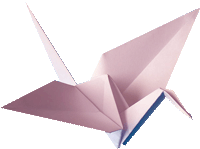About Origami

Origami is the Japanese art of folding paper into shapes representing
objects like flowers or birds. A Japanese word, the term 'Origami' literally
means to fold (oru) paper (kami). A fascinating and creative craft-making
art for kids, origami increases manual dexterity, and produces excellent,
decorative models out of paper.
History of Origami
Origami is of two types - ancient and contemporary. For practicing ancient
origami, you need only paper and your hands. In contemporary origami you can
add scissors, glue, etc.
The exact origins of origami is unknown and the art is said to have started
approximately two thousand years ago. But owing to the scarcity of written
records for the old period, there is great uncertainty over the origins of
origami. It cannot also be said whether the tradition first started in China
or Japan.
But the art of paper-folding is widely believed to have developed first in
China for paper was invented in China in the first century A.D. Then
Buddhist Monks brought paper to Japan in the sixth century. The first
Japanese folds date from that period. The art was however, restricted in
Japan to only the ceremonial occasions because paper was scarce. The old
origami figures were mainly shaped as animals, costumed people, and
ceremonial designs. Even though the modern ethic forbids it, the Japanese
people frequently used cuts in the paper. Japan developed origami to a very
high art form.
The oldest known written document about Japanese origami, the Senbazuru
Orikata ("How to Fold One Thousand Cranes"), surfaced in 1797.
There exist few written records of paper folding designs as most origami
instructions were passed on orally in olden days. Even the only ones that
are there are the simple ones. But the beauty and simplicity of these
origami instructions are undeniably appealing.
With the manufacturing of paper in the Arabian countries in the eight
century, origami got a wider reach. The Muslim people brought paper folding
to Spain in the twelfth century. Paper folding or papiroflexia subsequently
became very popular in Spain and South America. In Germany, origami caught
on with the kindergarten movement introduced around 1835 by Friedrich
Froebel. In England, papiroflexia became a popular children's hobby during
the reign of Queen Victoria, as evidenced by a couple of John Tunnel’s
illustrations for "Through the Looking Glass" by Lewis Carroll, featuring
two simple origami hats.
With the publication of the first works of original modern origami by master
artist Yoshizawa Akira in the 1950's, Origami got a tremendous boost and is
now a very popular thing to do. Though origami remains predominantly a
Japanese tradition (owing to its long history in Japan), it is now
considered a favorite pastime for children in the West. Since its origin,
there have been many changes in folding paper and there are much more
designs today. With time, simple folds have been recreated again and again.
These folds have surfaced both from the east and west.
To practice Origami, you must learn the following directions:
Directions
1. Select paper of good quality and cut it to the appropriate size and form.
2. Fold the paper neatly and carefully, especially at the edge of corners.
3. Work on a hard flat surface. This will ensure that all the folds are as
even as possible.
4. Smoothen the creases of all the folds by moving your thumbnail along the
paper edges. The more exact your fold, the more nice will be your finished
model.
5. Follow each step of your craft instructions carefully, and in the right
order. Practice folding your creases properly and cleanly. Your crafts would
just get better and better.
Back to Hobbies Main
